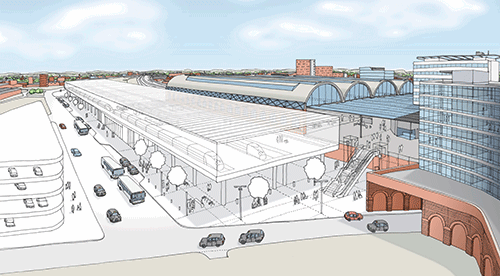 The planned construction of High Speed 2 (HS2) provides an exciting and important development in the history of rail travel in the UK. While the arguments for and against the building of the route have been extensively covered within the pages of RAIL over the past few years, it cannot be denied that the building of HS2 will be a huge economic boost to the cities served by the line, as well as helping to keep the UK at the forefront of modern railway development.
The planned construction of High Speed 2 (HS2) provides an exciting and important development in the history of rail travel in the UK. While the arguments for and against the building of the route have been extensively covered within the pages of RAIL over the past few years, it cannot be denied that the building of HS2 will be a huge economic boost to the cities served by the line, as well as helping to keep the UK at the forefront of modern railway development.
One of the key northern cities that will benefit from the arrival of HS2 is Manchester, which is within the Phase 2 section development of the new high-speed line. The city has undergone massive regeneration and growth, especially over the past two decades, and the establishment of a high-speed rail route to Manchester is seen as an important aspect in assisting the city to continue its aims of being a major and thriving part of the UK economy.
Phase 1 of the new route will run from London to Birmingham, and it is hoped that it will be completed in 2026. HS2 Phase 2 forms a ‘Y’ shape, from the West Midlands up towards Manchester and the North West with proposed stations at Manchester Airport and Manchester Piccadilly, and up towards Leeds and the North East with proposed stations in Leeds, the East Midlands and Sheffield Meadowhall.
While no earth has yet been broken (indeed, it is not expected that Phase Two of HS2 will be open for passenger services until 2033), plans for the arrival of HS2 are now at an advanced stage, with the route and infrastructure now largely agreed. It’s a massive project that will transform many areas of the UK, but the importance of the new line cannot be underestimated.
The proposed HS2 station for the Manchester terminus will be constructed alongside Manchester Piccadilly station, adjacent to Platform 1. The HS2 station will feature four platforms which will be elevated, with concourse facilities located at ground level beneath the platforms, providing a range of retail units and other passenger facilities. The station will be housed beneath an overall roof designed to complement the listed station roof over NR’s adjacent Piccadilly station, which is also expected to be further improved in preparation for the arrival of the high-speed trains.
It is hoped that the new Piccadilly station and facilities will become as successful as those at the current High Speed 1 terminus at London St Pancras, where the station has become a destination in itself.
The Piccadilly area of Manchester is very close to the city centre and has good road and public transport links. These will be further enhanced with the HS2 development to cope with predicted demands on the road and rail network in the area.
A lot of work has been carried out over the past few years to regenerate the Manchester area, but there is still much scope for improvement to the area that surrounds Piccadilly. The arrival of HS2 will help to kick-start the widespread regeneration of this area of the city.
The site of the HS2 station, alongside Piccadilly, is an obvious choice. The new high-speed line will also feature a station at Manchester Airport, but will approach Manchester via a seven-and-a-half mile tunnel beneath south Manchester, before emerging alongside NR metals at Ardwick for the final approach to Piccadilly.
Piccadilly is the principal main line station in the city, and it was extensively modernised and redeveloped in 2002 to coincide with the city hosting the Commonwealth Games. It currently features 14 platforms, with 12 terminus platforms and two through platforms. Proposals for future expansion of the station include provision for another two through platforms, which will increase the station’s capacity.
Beneath Piccadilly station, within the station undercroft, are the two Metrolink tram platforms, which were built within a specially-constructed ‘concrete box’ in 1991. Since the Metrolink station opened in July 1992, passenger usage of the tram stop has continued to grow. The widespread expansion of the Metrolink system since 2010 has increased Piccadilly’s importance, as more local communities have been able to benefit from a direct link to and from Manchester’s principal main line railway station.
Under the HS2 proposals, it is envisaged that the existing Metrolink platforms will need to be redesigned, or even relocated, to accommodate the HS2 station and its associated facilities.
However, the HS2 plans recognise the importance of Metrolink to the communities it serves and the tram facilities at Piccadilly will complement the heavy rail and high-speed services at the station.
Other proposed facilities around the station include a new coach station, enhanced car parking, taxi ranks, bicycle storage and better connections with other public transport operations in the city.














Login to comment
Comments
No comments have been made yet.